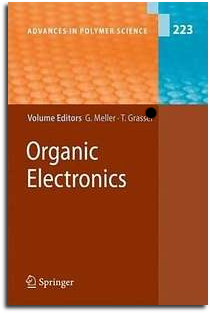Book Information

Organic Electronics
- Editor: Meller, Gregor; Grasser, Tibor
- Published: 2009, 328 pages
- ISBN: 978-3-642-04537-0
- Information from Amazon
Abstract:
The strengths of semiconducting polymers are currently mainly unfolding in cheap and easily assembled thin film transistors, light emitting diodes, and organic solar cells. The use of so-called “plastic chips” ranges from lightweight, portable devices over large-area applications to gadgets demanding a degree of mechanical flexibility, which would overstress conventional devices based on inorganic, perfect crystals. The field of organic electronics has evolved quite dynamically during the last few years; thus consumer electronics based on molecular semiconductors has gained sufficient market attractiveness to be launched by the major manufacturers in the recent past.
Nonetheless, the numerous challenges related to organic device physics and the physics of ordered and disordered molecular solids are still the subjects of a continuing lively debate.
The future of organic microelectronics will unavoidably lead to new device-physical insights and hence to novel compounds and device architectures of enhanced complexity. Thus, the early evolution of predictive models and precise, computationally effective simulation tools for computer-aided analysis and design of promising device prototypes will be of crucial importance.
With regard to novel developments and challenges, the organizers of the SISPAD 2007 conference decided to organize an “Organic Electronics” Companion Workshop. World leading experts have been invited to Vienna to present their current work on this fascinating and important field of research. Subsequent to the workshop, all participants, together with those scientists who were regrettably unable to join the conference, have been invited to contribute a chapter to the present volume of the book series “Advances in Polymer Science.”
Table of Contents:
• Steady-State Photoconduction in Amorphous Organic Solids (H. Bässler and E.V. Emelianova)
• Effective Temperature Models for the Electric Field Dependence of Charge Carrier Mobility in Tris(8-hydroxyquinoline) Aluminum. (P.J. Jadhav, B.N. Limketkai, and M.A. Baldo)
• Description of Charge Transport in Disordered Organic Materials (S.D. Baranovskii, O. Rubel, F. Jansson, and R. Österbacka)
• Drift Velocity and Drift Mobility Measurement in Organic Semiconductors Using Pulse Voltage (D. Basu and A. Dodabalapur)
• Interfaces in Organic Field-Effect Transistors (G. Horowitz)
• Low-Cost Submicrometer Organic Field-Effect Transistors (S. Scheinert, G. Paasch, I. Hörselmann, and A. Herasimovich)
• Bio-Organic Optoelectronic Devices Using DNA (T. B. Singh, N. S. Sariciftci, and J. G. Grote)
• Organic Field-Effect Transistors for CMOS Devices (C. Melzer and H. von Seggern)
• Theories of the Charge Transport Mechanism in Ordered Organic Semiconductors (A. Troisi)
• Charge Transport in Organic Semiconductor Devices (L. Li and H. Kosina)
